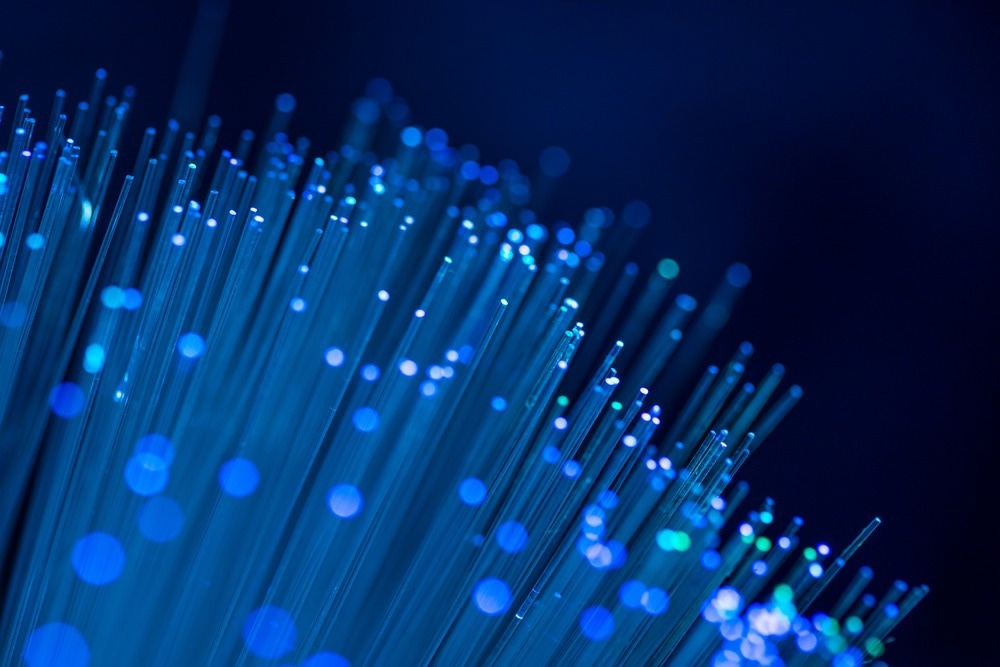In this piece, we discuss the applications and functions of fiber optic communication, as well as current and future advancements in the field.

Image Credit: Pumidol/Shutterstock.com
Optical fibers are long flexible wires (fibers) constructed from plastic or glass that are able to transmit light from one end to the other. This permits much higher rates of data transmission than typical electrical cables with less loss while possessing other advantages, such as resistance to electromagnetic radiation. Fiber optic methods of communication were first developed in practical terms in the 1970s and have played a major role in the advent of the information age, largely replacing electrical transmission in high-throughput, long-distance, and backbone networks.
When Was Fiber Optic Communication Developed?
Voice communication using light was achieved by Alexander Graham Bell and Charles Sumner Tainter in their invention, the photophone, which used a flat mirror that responded to the vibrations of the users voice. Light reflected from this mirror was then cast to the receiver’s parabolic mirror and focused onto a selenium cell; the pattern of light converted to electronic and then audible signal.
A transmission distance of around 200 meters was achieved at this time, though with significant distortion owing to the nature of atmospheric transmission. Much more powerful lasers or fiber optic technology would be needed before this technology could become feasible as a method of communication.
Rolled glass was developed as a fiber optic medium throughout the 1950s and 60s; massive advances were made in the capabilities of lossless transmission, coming with the discovery that contaminants within the glass were the primary source of losses by Charles Kao and George Hockham.
The first true fiber optic communication was achieved in 1977 in Long Beach, California, when General Telephone and Electronics sent the first communications at a rate of 6 Mbit/s. The same year, a much higher inner-city rate of 140 Mbit/s was achieved in Turin, Italy, by collaborative efforts between Corning Glass, Pirelli, and Italian communications research center CSELT.
What are Single-Mode and Multi-Fore Fibers?
During the early 1980s, most fiber optic communication cables were of multi-mode fiber dispersion, though it was discovered that single-mode fiber optic cables were generally superior. Multi-mode fibers are much larger than single-mode fibers, around 50-100 μm compared with only 8-10 μm. These larger diameters allow more light to be passed down the fiber, somewhat simplifying the electronics involved at the receiving end.
Light can also travel in both directions down multi-mode fibers, while single-mode fibers are uni-directional. Multi-mode fibers, however, suffer from much shorter usable length and information capacity, as they are influenced by modal and chromatic dispersion. As light can only travel one way down single-mode fiber optics, or more properly stated, there is only one propagation mode, light can be focused onto a diffraction limited spot, i.e., the maximum resolution possible for a theoretically perfect optical system. This has various uses in research and other precise optical systems.
Multi-core optical fibers, as the name suggests, contain multiple cores, effectively single-mode optical fibers, within a single fiber, massively improving overall bandwidth capacity through a single contained fiber in the same small form factor.
Typically, between four and eight single-mode fibers may be contained within a multi-core fiber, evenly distributed within a protective sheath, around 125 μm in diameter. Multi-core fiber optic communication is highly anticipated and has not yet been broadly implemented in undersea fiber optic communication lines.
One of the problems faced by multi-core fibers is in alignment with the receiving device or fibers at the end of the transmission line, as unlike traditional electronics, they need to do more than simply make contact and must be entirely light-tight and aligned with a high degree of precision. Dealing with multiple independent light-transmitting fibers of such fine diameter therefore poses optical challenges related to separation.
Are There Other Applications for Multi-Core Fibers?
Multi-core fibers are also useful interferometers owing to the possibility of weak and strong coupling between the multiple cores, depending on their closeness of positioning. Interferometry is a method of measurement utilizing destructive and constructive interference of light waves, in this case, and thus coupled single-mode fibers are carrying light in resonance with one another.
Bending and dynamic movement in the fiber, including vibration, curvature, twisting, vector bending, and fluid flow, can therefore be interpreted based on the changing interaction of coupled single-mode fibers within a single multi-core fiber.
Other external parameters have been measured using multi-core fibers, such as temperature, gas concentration, and refractive index of the environment, amongst others. These latter types of fiber optic sensors operate using integrated sensing units, which collect light from the fiber optic cable and detect changes in light intensity, scattering angle, speed, and other parameters as it passes through air.
Particular molecules absorb certain wavelengths of light more strongly than others, depending on molecular composition and relating to electron excitation energies, and thus changes in light intensity at these wavelengths can be indicative of the presence of said molecule. Temperature measurements are usually based on changes in refractive index; as the density of atmospheric gasses changes with temperature, light is scattered to a slightly differing degree as it passes through.
Ultrafast Nonlinear Optics for Laser Pulse Compression
References and Further Reading
Ortiz, A. M., & Sáez, R. L.. (2018). Multi-Core Optical Fibers: Theory, Applications and Opportunities. https://doi.org/10.5772/intechopen.72458
Yao, Y., Zhao, Z., & Tang, M. (2023). Advances in Multicore Fiber Interferometric Sensors. Sensors, 23(7), 3436. https://doi.org/10.3390/s23073436
Multi-Core Fiber:The highly anticipated, next-generation high-speed communication technology https://orbray.com/magazine_en/archives/2240
Disclaimer: The views expressed here are those of the author expressed in their private capacity and do not necessarily represent the views of AZoM.com Limited T/A AZoNetwork the owner and operator of this website. This disclaimer forms part of the Terms and conditions of use of this website.